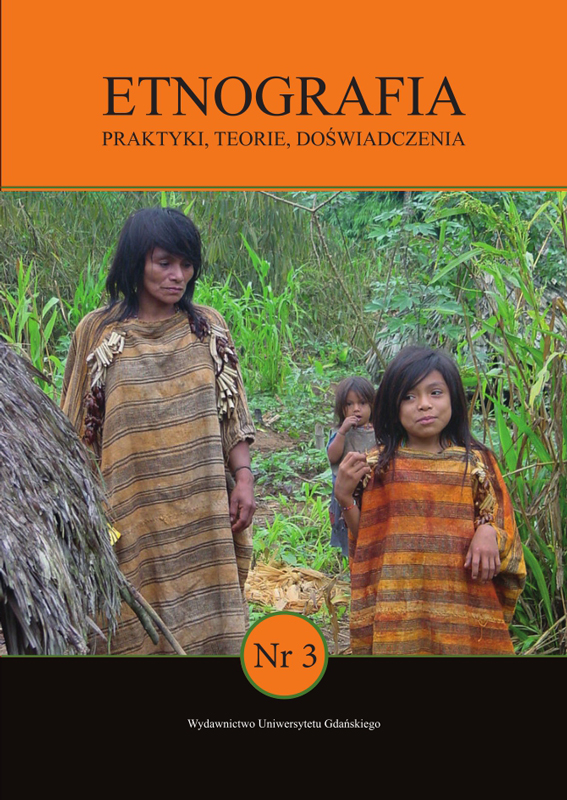Reproduction and aggression: shamanic practices among Quichuas from Ecuador (Imbabura and Chimborazo Provinces)
DOI:
https://doi.org/10.4467/254395379EPT.17.009.9245Słowa kluczowe:
shamanism, Ecuador, Quechua, indigenous worldviewAbstrakt
This paper describes the contemporary shamanism among Quichua from the Ecuadorian Andes (Imbabura and Chimborazo provinces in the Sierra region), shaman’s roles and his status in local indigenous communities. Basing on the Quichua worldview, I show what the key elements of shamanic practices are and what is its importance to the continuity of Quichua life and culture. The thesis of this text is that shamanism has two complementary faces. The Quechua shamanism in Ecuador is based on social reproduction or construction (healing, maintaining the fertility of nature and people) and aggression at the same time (witchcraft).
Downloads
Bibliografia
Boddy, J. (1989). Wombs and Alien Spirits: Women, Men, and the Zar Cult in Northern Sudan. Madison: University of Wisconsin Press.
Caillavet, Ch. (2000). Etnias del Norte: Etnohistoria e Historia de Ecuador. Madrid: Casa de Velazquez.
Cifuentes, M. (1992). Medicina andina: situaciones y respuestas. Quito: CAAP.
Cobo, B. (1943). Historia del Nuevo Mundo. Madryt: Atlas.
Crickmay, L. (2002). Transmissions of Knowledge Through Textiles and Weaving and Learning How to Live. In: H. Stobart, R. Howard (eds.), Knowledge and learning in the Andes: ethnographic perspectives (pp. 40–55). Liverpool: Liverpool University Press.
Descola, P. (1996). Constructing natures: symbolic ecology and social practice. In: Ph. Descola, G. Pálsson (eds.), Nature and society. Anthropological perspectives (pp. 82–102). London–New York: Routledge.
Descola, P. (2013). Beyond nature and culture. Chicago: University of Chicago Press.
Eliade, M. (1994). Archaiczne techniki ekstazy. Trans. K. Kocjan. Warszawa: Wydawnictwo Naukowe PWN.
Gow, P. (1996). River people: Shamanism and History in Western Amazonia. In: N. Thomas, C. Humphrey (eds.), Shamanism, History and the State. Ann Arbor: University of Michigan Press.
Guinea Bueno, M. (2004). Los simbolos del poder o el poder de los simbolos. In: M. Guinea ueno (ed.), Simbolismo y ritual en los Andes septentrionales (pp. 9–50). Quito: Abya-Yala.
Harner, M. J. (1980). The Way of the Shaman: A Guide to Power and Healing. New York: Harper & Row Publishers.
Harner, M. J. (1984). The Jívaro, People of the Sacred Waterfall. Berkeley: University of California Press.
Humphrey, C. (1994). Shamanic practices and the State in Northern Asia: view from the center and periphery. In: N. Thomas, C. Humphrey (eds.), Shamanism, History, and The State. Ann Arbor: University of Michigan Press.
Joralemon, D. (1985). Altar Symbolism in Peruvian Ritual Healing. Journal of Latin American Lore, 11, 3–29.
Kessel Brouwers van, J. (1997). La tecnología simbólica en la producción agropecuaria andina, In: J. Van Kessel, H.Larraín Barros (eds.), Manos sabias para criar la vida (pp. 33–56). Quito: Abya-Yala.
Mair, L. (1969). Witchcraft. Nowy Jork: McGraw Hill.
Mauss, M. (2001). Socjologia i antropologia. Trans. M. Król, K. Pomian, J. Szacki. Warszawa: Wydawnictwo KR.
Middleton, J. (1960). Lugbara Religion. London: Oxford University Press.
Millones, L. (1979). Los Ganados de Señor: Mecanismos de Poder en las Comunidades Andinas, Siglo XVIII y XIX America Indígena, 39(1), 107–145.
Noel, D. C. (1997). Soul of Shamanism: Western Fantasies, Imaginal Realities. Verlag: Continuum International Publishing Group.
Paz Otero, G. (1974). La Medicina en la Conquista y la Colonia. Bogota: Editorial GAB.
Price, N. (2011). Shamanism. In: Timothy Insoll (ed.), The Oxford Handbook of the Archaeology of Ritual and Religion. New York: Oxford University Press.
Przytomska, A. (2012). Relacja medycyny andyjskiej i brujería w kontekście współczesnych praktyk leczniczych i kosmowizji Indian Kiczua z Andów ekwadorskich. Indigena. Przeszłość i współczesność kultur amerykańskich, 1, 66–89.
Przytomska, A. (2013). Sytuacja Indian w Ekwadorze na tle polityki wielokulturowości. Program Salud Intercultural jako przykład nierówności społecznych i kulturowych. Dialog Międzykulturowy, 1, 34–47.
Przytomska, A. (2015a). Historia tubylcza. Szamani Kiczua i mitopraktyka, Etnografia. Praktyki, Teorie, Doświadczenia, 1, 84–107.
Przytomska, A. (2015b). Szamani a szkoła. Przeobrażenia modelu szkoły państwowej w kontekście kosmowizji współczesnych Indian Kiczua. In: T. Buliński, M. Rakoczy (eds.), Communicare, Almanach antropologiczny, T. 5. Szkoła/Pismo (pp. 199-215). Warszawa: Wydawnictwa Uniwersytetu Warszawskiego.
Quinteros, Velasco M. (2006). La población indígena del Ecuador. Análisis de estadísticas socio- -demográficas. Quito: Talleres Gráficos del INEC.
Reichel-Dolmatoff, G. (1987). Shamanism and art. Of the eastern Turkanoan Indians. Leiden: Brill.
Salomon, F. (1983). Shamanism and politics in the late-colonial Ecuador. American Ethnologist, 10, 413–428.
Sharon, D. (1976). Distribution of the Mesa in Latin America. Journal of Latin American Lore, 2(1), 71–95.
Silverblatt, I. (1983). The evolution of witchcraft and the meaning of healing in colonial Andean society. Culture, Medicine and Psychiatry, 7, 413–427.
Stoller, P. (1995). Embodying Colonial Memories: Spirit Possession, Power and the Hauka in West Africa. New York: Routledge.
Szirokogorow, S.M. (1982 [1935]). Psychomental Complex of the Tungus. London: Kegan Paul, Trench, Trubner & Co. Ltd.
Szyjewski, A. (2001). Etnologia religii. Kraków: Zakład Wydawniczy Nomos.
Taussig, M. (1987). Shamanism, Colonialism, and the Wild Man: A Study in Terror and Healing. Chicago: University of Chicago Press.
Tokariew, S.A. (1969). Pierwotne formy religii i ich rozwój. Trans. M. Nowaczyk. Warszawa: Książka i Wiedza.
Vitebsky, P. (1995). The Shaman: Voyages of the Soul, Trance, Ecstasy and Healing from Siberia to the Amazon. London: Duncan Baird Publishers.
Wallis, R. J. (2003). Shamans/neo-Shamans: Ecstasy, Alternative Archaeologies and Contemporary Pagans. London: Routledge.
Ward, K. (1994). Religion and Revolution: a Theology of Revelation in the World’s Religions. Oxford: Clarendon Press.
Wasilewski, J. (1979). Podróże do piekieł. Rzecz o szamańskich misteriach. Warszawa: LSW. Whitehead, N.L., Wright, R. (2004). In Darkness and Secrecy. The Anthropology of Assault Sorcery in Amazonia. Durham: Duke University Press.
Wierciński, A. (2000). Magia i religia. Szkice z antropologii religii. Kraków: Nomos.
Wilbert, J. (1972). Tobacco and Shamanic Ecstasy Among the Warao Indians of Venezuela. In: P.T. Furst (ed.), F lesh of the Gods: The Ritual Use of Hallucinogens. London: Allen and Unwin.
Yáñez del Pozo, J. (2005). Allikai: bienestar/estar bien la salud y la enfermedad desde la perspectiva indígena. Quito: Abya-Yala.
Pobrania
Opublikowane
Jak cytować
Numer
Dział
Licencja
Czasopismo wydawane jest na licencji Creative Commons Uznanie autorstwa-Na tych samych warunkach 4.0 Międzynarodowe.

 Uniwersyteckie Czasopisma Naukowe
Uniwersyteckie Czasopisma Naukowe








